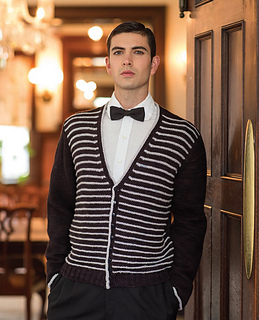patterns > Piecework >  The Unofficial Downton Abbey Knits 2013 and 1 more...
The Unofficial Downton Abbey Knits 2013 and 1 more...
> Status Symbol: Footman's Vest





Status Symbol: Footman's Vest
Lower on the servant pecking order than a butler or valet, a footman was not common except in upper-class households, and the position eventually disappeared in the period between World War I and II. While a butler or valet would generally wear a jacket and tie (a tailcoat in the evening with a black tie, differentiating them from gentlemen who wore white ties with tails), a footman wore a “Footman’s Vest.” To call this garment a “vest” may seem a misnomer, but the garment worn by footmen as they went about their daily activities often had sleeves (either detachable or as part of the garment.) These sleeves protected the white shirtsleeves from the grime of every day work, while at the same time keeping the status of the wearer obvious to all. The stripes used in the front body of the garment were common, often worked either vertically or horizontally, and seldom extending to the back. The sleeves were rarely patterned in any way.
6084 projects
stashed
3882 times
551 projects
stashed
723 times
- First published: November 2013
- Page created: July 30, 2014
- Last updated: May 30, 2023 …
- visits in the last 24 hours
- visitors right now




